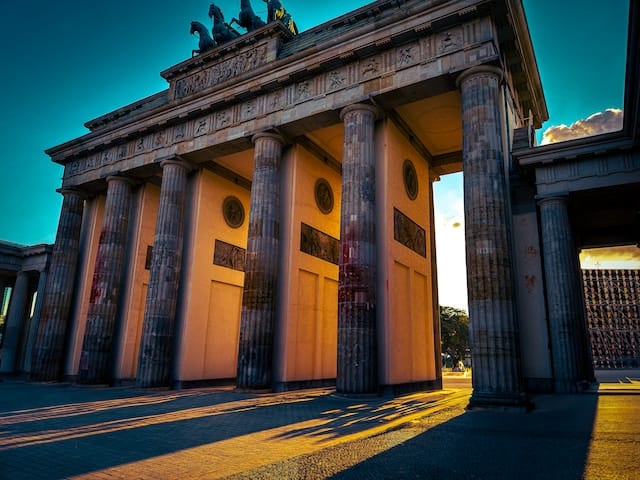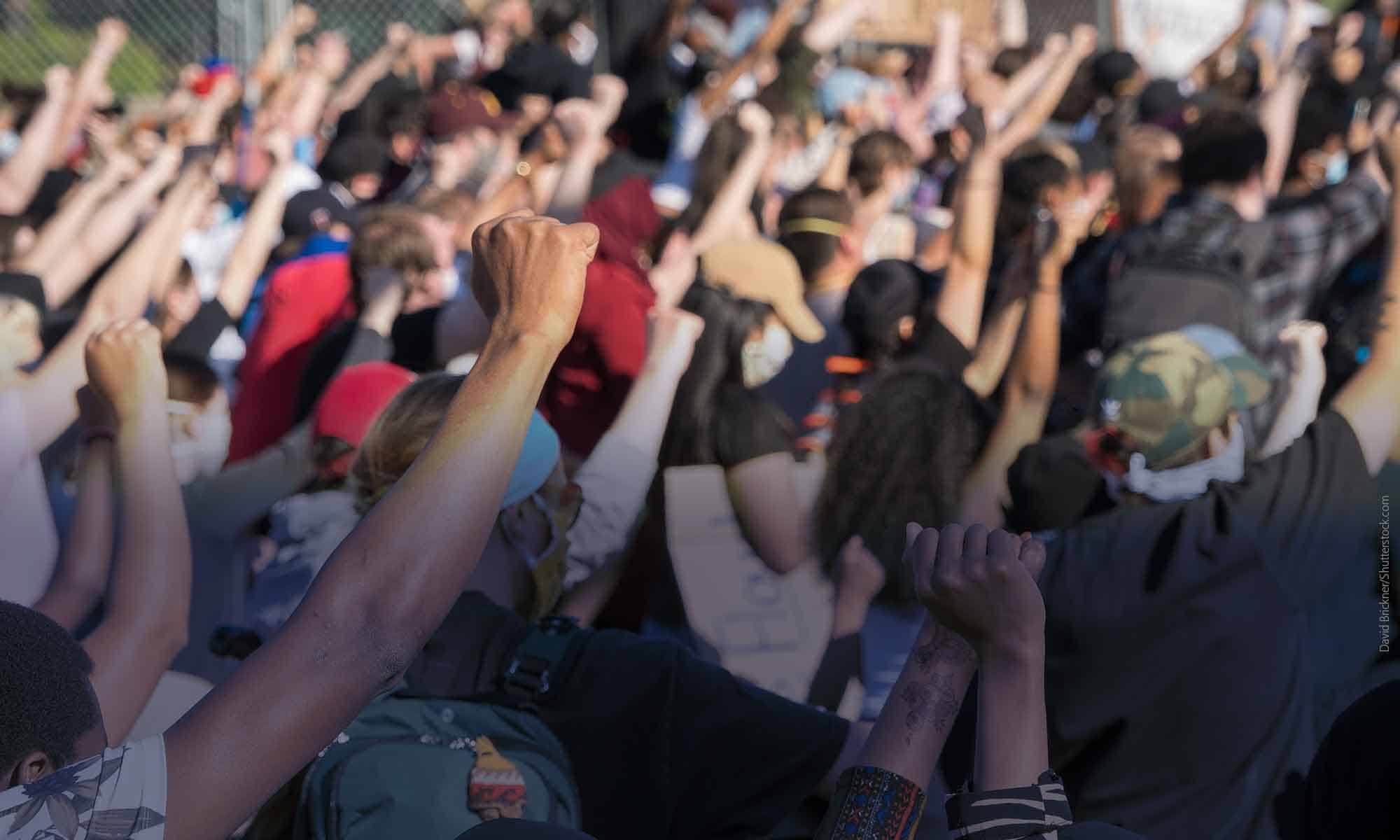Gluing oneself to the streets, pour soup over famous paintings in museums or pour orange color over sights. Are the members of “The Last Generation”, that often perform those tactics, “climate extremists”? Or are they practicing civil disobedience?
Definitions, Development and Discussion about Legitimacy.
Translated and edited by Dr. Bernd Bürger & Jacklyn Keane, with kind permission of the original article’s author Prof. Dr. Armin Pfahl-Traughber.

Climate activists often justify their road blockades as necessary civil disobedience. Others see these forms of protest as questionable violations of the law. This has sparked an emotionalized and polarized debate that has occurred once before in the Federal Republic of Germany. In the early 1980s, supporters of the peace movement carried out similar protest actions, for example with sit-in blockades in front of German military installations. At the time, there was an intellectual debate questioning the legitimacy of civil disobedience. This is not the case today. Nevertheless, a differentiated view could calm minds and advance a necessary factual debate. Civil disobedience is an expression of the tensions between the state and some of its citizens, and should be analyzed. This article aims to illustrate the political philosophy of this phenomena.
Definition of Civil Disobedience
In general, civil disobedience is an act of refusal, one does not comply with applicable laws and regulations. The term “civil” suggests a non-violent action and implies the importance of a social context. American philosopher and publicist Henry David Thoreau is considered the modern founder of civil disobedience, his well-known 1849 essay “Resistance to Civil Government” has become a classic. In it, he talks about a brief stint in prison for refusing to pay taxes in protest of slavery. According to the text, his individual conscience motivated him to take this action. According to Thoreau, civil disobedience was the conscious negation of a legal duty derived from one’s own moral sense.
Individual components of civil disobedience
Civil disobedience as a form of protest entails various problems of legitimacy. First, the breaking of applicable laws, which entails committing a criminal offense. Second, there is a need for legitimation, higher values above the law must be emphasized. Third, the question arises whether one otherwise accepts the law partially or rejects it, in its entirety. In the case of the example mentioned above, this was a complex problem, since the practice of slavery contradicted the constitutional principles laid down. Fourth, it is a question of one’s attitude to the consequences of the respective violation of the law, which, like the law, can be generally accepted or not.
Differentiation of legality and legitimacy in civil disobedience
It is also necessary to differentiate between legality and legitimacy in this form of protest. The term legality generally means that activities adhere to a law, this applies to both a dictatorship and a democratic constitutional state. However, this is not the case with the practices of civil disobedience. In a dictatorship, the question of legitimacy is different, as the dictatorship is the result of repressive power, which cannot be changed by the citizens. Thus, the only possible course of action are illegal forms of protest. Civil disobedience activities do not require any special legitimation, because under the dictatorial order there is no democratic legitimacy under the rule of law. The situation is different in a democratic constitutional state, where political decisions could be changed through legal action. As a result, it is important to discuss the legitimacy of civil disobedience. There are three distinguishable positions:
Position 1: Rejection of civil disobedience in a democracy
The starting point of this rejection is that an intentional breach of the law and a derived possible generalization would entail problematic effects. A minority would emerge who disregards the rules by prioritizing their individual “conscience,” this would ultimately become the primary yardstick of political practice. Consequently, this leads to a dangerous erosion of the vital foundations of politics. Supporters of this argumentation see civil disobedience as a threat to democracy.
Position 2: Affirmation of civil disobedience in a democracy
A second view affirms civil disobedience in a democracy, although it does not assume that protest practice is legal, but legitimate. The supporters of this constitutional view, such as the philosophers Jürgen Habermas and John Rawls, named different prerequisites that are necessary for this form of protest to be legitimate. First, the determination of conscience as a source of legitimacy, which is tied to the common basic values of a political order characterized by justice. Second, non-violence, since civil disobedience should not be about threats, but about admonitions. Third, the public nature of the intended acts of protest since the actors must stand for their deeds with their faces and names. This would go hand in hand with the acceptance of the legal consequences of their illegal practices, which would document the recognition of the institutions of an existing legal system.
Position 3: Negation of the democratic constitutional state through civil disobedience
And then there is a third view, which wants to overcome the existing democratic constitutional state, for example by means of civil disobedience. This is based on a negative view of Western democracies, which are seen as imperialist and capitalist systems to be rejected. Well-known adherents of this interpretation were the sociologist Herbert Marcuse and the historian Howard Zinn, who were intellectual role models for the Sixty-Eight Movement with their vehement social criticism. As authors, they repeatedly emphasized their opposition to the existing state, which they saw as an instrument for pursuing influence, power, and wealth. At that time, these objections referred to the conditions in the USA where they saw the black ghetto population and the left-wing students as parts of a new revolution that would fight for a free society through the means of civil disobedience. Accordingly, this served as a political instrument to advance a real change of societal and political institutions.
Attitude toward the democratic constitutional state as a distinguishing criterion
The first and third views, for all their substantive differences, have a formal correspondence: They see a fundamental contradiction between the democratic constitutional state and civil disobedience. The difference lies in the different attitude toward the existing democratic constitutional state, which is accepted in the former position and negated in the latter. The first view interprets the intended forms of protest as fundamentally reprehensible, since such actions would reject the constitutive rules of the democratic constitutional state. Here, a fixation on legalism can be observed. The third view, on the other hand, sees the democratic constitutional state as an illusory sham that should be overcome through the practice of civil disobedience. Here, civil disobedience is seen as an instrument for system transformation. Accordingly, both considerations reject one point of view, the democratic constitutional state on the one hand and civil disobedience on the other.
Components of a Constitutional Conception of Civil Disobedience
The second conception, which will henceforth be referred to as the constitutional conception of civil disobedience, is different. Those acting under this conception accept the existing constitutional state. Nevertheless, in relation to a particular political concern, they believe that existing laws must be broken for the sake of its public perception. The ambivalence of these attitudes are unmistakable, which makes it necessary to take a close look at their respective characteristics. The most differentiated formulation of the conception meant is found in Rawls, which include, first, determination of conscience, second, non-violence, third, illegality, and fourth, publicity. The intention of relevant actions in this sense should be to bring about a change in the laws or in government policy. An example of the four components would be demonstrators in order to bring attention to their plight of climate change, glue themselves on public streets to block traffic and livestream on social media.
Determination of Conscience as the First Characteristic of Constitutional Civil Disobedience
The starting point here is the affirmation of a functioning democracy with shared notions of justice. Accordingly, there must be the impression among protesting citizens that the spirit of these basic principles is being violated by real politics. Accordingly, based on their acceptance of constitutive basic values, they use civil disobedience against real politics to motivate the social majority, such as the elected government, to rethink. This is how one breaks the law within the framework of the rule of law.
Non-violence as the Second Characteristic of Constitutional Civil Disobedience.
The first element in this context is non-violence, which primarily means the rejection of bodily harm during protest actions. This does not even have to be a fundamental negation of such practices; what is more decisive here is the appeal function of civil disobedience. For it should not be about forcing opinions, but about converting the public to the demonstrators’ viewpoint. What remains unclear here is the attitude toward violence against property, which would mean that we would be dealing with the action style of sabotage. Such practices are in a transitional area to violent resistance.
Illegality as a Third Characteristic of Constitutional Civil Disobedience
In addition, the constitutive characteristic of civil disobedience is illegality: One deliberately breaks applicable laws in the name of higher values. Thus, all these activities are criminal acts, which leads to the problem of legitimacy vis-à-vis the understanding of the rule of law. However, the activities in question are supposed to be within the bounds of law-abidingness, even if the law is broken. Both views can be in harmony with each other, insofar as the breaking of the law is an exception, just being committed as a means of protest and otherwise all laws and the rule of law are being accepted. Law-breaking action, for example a blockade of a street, wants to send a signal, especially to the public. By using those means, the protesters want to document the urgency and seriousness of their concerns to have a moral effect on the majority or the government.
Publicity as the fourth characteristic of constitutional civil disobedience.
The publicity of civil disobedience is the last characteristic. This means, that relevant protests must be carried out in a way that is easily perceivable by the media, since this is the only way to influence the ways of thinking and attitudes of the social majority. Even more important, however, is the public appearance as a concrete person, i.e., standing with one’s face and name for the illegal acts of protest. In doing so, the actors do not evade possible arrest or conviction. The possible conviction leads to a personal credibility of the protestors as they are willingly to publicly stand trial and be convicted for their viewpoints. This kind of action also contrasts with clandestine and conspiratorial actions, such as those involving considerable damage to property and fugitive perpetrators. They do not have the willingness to accept punishment. It is precisely in this question that the difference between the second and third positions on civil disobedience becomes clear.
Activities of the Climate Movement and Positions on Civil Disobedience
What about the Climate Movement and their position on civil disobedience? Their activities do not give the impression that they have considered closely the political philosophy of civil disobedience. Rather, their actions seem like spontaneous practices out of the situation. Nevertheless, they should be examined based on discussion above. First, it is a matter of deliberate breaking of the law for political motives; the banners of the “Last Generation”, for example, openly display the slogan “We break the law” (this slogan is based on the fact that the Federal Constitutional Court ruled that parts of the German government’s climate laws were not fully compliant with the constitution). No physical violence is used in the activities; even verbal ins are frowned upon. In addition, people identify themselves to the police by face and name. Previous fines and imprisonment were accepted by the protesters, and they accepted the consequences of breaking the law.
Inappropriate protest practices for constitutional civil disobedience.
Regarding these aspects, there are fundamental differences compared to the left-wing extremist autonomists, who cannot use the concept of constitutional civil disobedience for their actions. Nevertheless, objections may be raised against the forms of protest practiced by “The Last Generation” in particular: Actually, such actions are supposed to be about addressing social majorities. This is precisely what the group’s actions fail in doing, despite broad acceptance for climate protection. This is because the public debate primarily relates to the consequences of the street blockades, not to the climate policy decisions that are considered inadequate. Furthermore, there are no recognizable connections between the individual actions and the substantive concern, such as the destruction of art has no logical nexus to climate protection. Such actions are obviously more about the group’s own public presentation, and less about promoting more climate protection in social life. However, this violates a basic principle of constitutional civil disobedience.
Conclusion
Even among most of the actors in the climate movement who refer to the concept of civil disobedience in their actions, the concept itself seems not well known. There is certainly a tension existing vis-à-vis the democratic constitutional state, but not necessarily a fundamental contradiction. This insight is also not clear to the other side in the controversy. The terms circulating there, such as “climate extremists” or even “climate terrorists,” do not address the actual problem, thus forcing a polarization without communication on both sides. This goes against the goal of civil disobedience which is to open lines of communication in order to effect societal/political change. This polarizing development is surprising in view of a broad consensus on the factual issue, since all those involved advocate more climate protection as the respective objective. Perhaps, if the climate movement altered their civil disobedience to be more specific to their goal of bringing awareness to their explicit plight, the majority and governments would be more inclined to listen.

